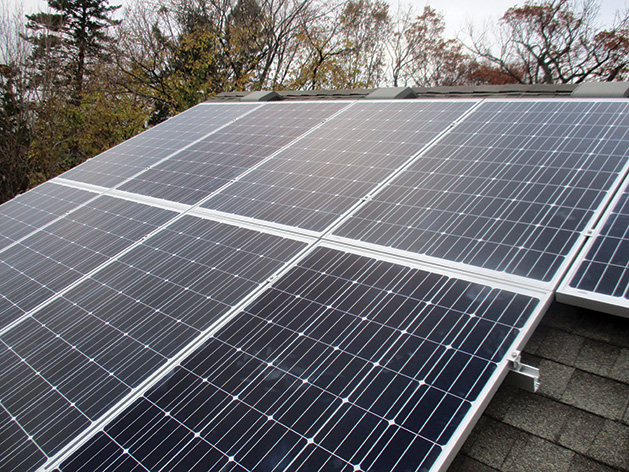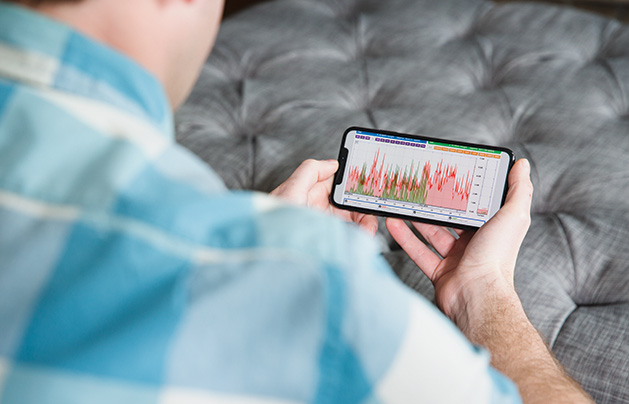
Photos: Rachel Nadeau
Solar cuts local homeowners’ energy costs.
On a winter day earlier this year, the mercury dropped below zero and a bitter north wind froze cringing faces. But the sun shone brightly in a blue sky, as it often does on the coldest days—a sort of meteorological consolation prize. Days like that are partly why Minnesota, despite its frigid reputation, is actually a viable place to employ photovoltaic, solar energy technology.
Even on those cold days, as long as it’s sunny, homeowners Sid and Brian Curtis of Minnetonka and Travis and Kristy Mills of Mound are turning sunlight collected by their rooftop photovoltaic panels into “free” energy. Their homes are among more than 200 in the Lake Minnetonka area with solar systems made and installed by a St. Paul-based firm, All Energy Solar.
The Curtises had been looking into solar for the past five or six years, checking for tax credits and rebates that would lower the cost. With credits and rebates in effect last year, they were able to have a rooftop system installed on their garage last fall, for an investment of only $1,000, Sid says. A federal tax credit cut their cost by about a third. A loan paid for the solar panels.

“The amount of energy we produce each month saves us more than the cost of the loan. Once the loan is paid off, the excess energy produced will be sold to [energy provider] Xcel,” Sid Curtis says.
With storage batteries mounted on the back of the garage, the system feeds power back to Xcel. As a result, rather than paying monthly for power, they received credits of $323 and $67 dollars on their past two Xcel bills (as of this writing in early spring). They expect those credits to grow during the spring and summer months when days are longer.
Sid Curtis says another feature she appreciates is that the system keeps track of how much energy each of their 28 solar panels is generating. “If too much tree shade is impacting productivity, we can identify that and do something about it,” she says.
Travis and Kristy Mills, who live in Mound, have cut their energy costs roughly in half since installing an All Solar system in November of 2017. They’re both conscientious energy consumers who consider themselves “very conscious” of their impact on the environment, Kristy says. Their work reflects that—both are professors at St. Paul College. Several years ago, Travis did research on advances in organic semi-conductors when he was working toward his Ph.D.

In fact, Travis’ research led to the Millses’ current investment aimed at reducing their carbon footprint: their solar energy system. The 9.7-kilowatt system has 29 solar panels mounted on the home’s south-facing roof. The energy generated, which is sent to Xcel Energy’s grid, has cut their monthly bill roughly in half. That includes the electricity needed to provide a daily charge to their Tesla electric car.
They received two rebates on the system: a Made In Minnesota rebate from Xcel, and a 30-percent tax credit on the system cost from the state of Minnesota.
Obviously, the system generates less power during the shorter days of winter, and produces considerably more energy than the Millses consume during bright summer months. People typically wonder about heavy snow covering up the panels, but panels are installed at an angle that enables them to shed snow.
Photovoltaic technology has been in use for over 50 years, and during that time has become more efficient and affordable. As solar panels generate DC electricity from the sun, that energy flows into an inverter where it will be conditioned into AC electricity. Solar modules carry a standard 25- to 30-year production warranty, and a solar electric system that is designed, installed and maintained properly can last more than 40 years, according to industry experts.
Solar energy works because it “is based on fairly simple scientific principles, and something that doesn’t require a lot of maintenance, since it’s static technology that doesn’t move in the wind,” says Mike Allen, who founded All Energy Solar along with his younger brother, Brian. Brian became interested in solar while a business management/economics major at the University of Wisconsin.
For his senior thesis, he spent time working in Europe and did a comparison of American and European renewable energy practices. He realized solar was a viable technology and also that “the U.S. was so far behind, it was like night and day. It was a big eye-opener seeing renewable technology being used and working in Europe, in a big way,” Mike Allen says.
Before founding their company, the Allen brothers spent seven years working for solar companies on the east and west coats, working their way up through sales and into management roles. Mike Allen ran a major solar company on the east coast for several years. The experience has helped them avoid management mistakes made by some other solar energy providers, he says.
Using about $15,000 in savings, the brothers started All Energy in St. Paul in 2010. They established an east coast branch with a Boston-based employee in 2011. That geographical diversity has helped the company weather the changes in government incentive programs that have, at times, posed a challenge for solar entrepreneurs.
Two simultaneous trends have made solar a viable option, Mike Allen says. “The cost of electricity has risen, and the cost of solar has come down dramatically”—including the systems that generate the electricity and transmit it to the main power grid, and the batteries used to store it. For businesses, “energy used to be an afterthought. But the cost of electricity is getting to the point where it can be a significant line item for businesses,” Allen says.
More effective, more affordable storage batteries “have helped take solar to the next level and allow it to be considered a viable source of power for anyone,” Allen says. “Prior to storage being affordable, it was a limiting factor. Storage allows people to have the solar system continue to work while the power is out, providing energy security and peace of mind.”
Allen says one of his customers who lives on Lake Minnetonka lost power from the traditional grid 11 times in six months, but his solar system kept power flowing to the home, uninterrupted.
With the new systems, users can “tell” a battery when to turn on and off, to reserve battery life for storms and other situations. “The technology has gotten so advanced we can predict storms or other issues and start preparing. It’s all done on the back end, with computer programs. It’s turned energy consumption into really ‘smart’ home technology,” Allen says. The new batteries also take up less space; the wall-mounted units Allen sells are three to four feet in length and six inches deep.

Based on power capacity, the systems All Energy sells range from about $15,000 to as high as $100,000 for larger systems.
Of course, government-mandated rebates can lower costs. The current 30-percent federal tax credit for residential and commercial solar will become 26 percent at the end of 2019 and will end in 2022. The state rebates provided by Xcel Energy are also continuing to decrease. Those rebates are first-come, first-served, each year.
Allen calls Minnesota a “fantastic” place to do solar, noting that we receive about the same amount of sunlight annually as Houston, Texas. “Even in the winter we get sunny days,” he says.
Solar still has a long way to go to reach its potential in this country, Allen believes. “Solar still seems like a foreign concept to a lot of people; even though it involves very basic scientific principles, people still ask if it even works. But it’s fairly simple to install and let it do its thing. To break that barrier, we found we need to make the process as simple as possible and hold their hands through the process. What we’re trying to do is get people to understand that they have a choice in how and where they get their electricity.”
All Energy Solar
1642 Carroll Ave., St. Paul
800.620.3370






















